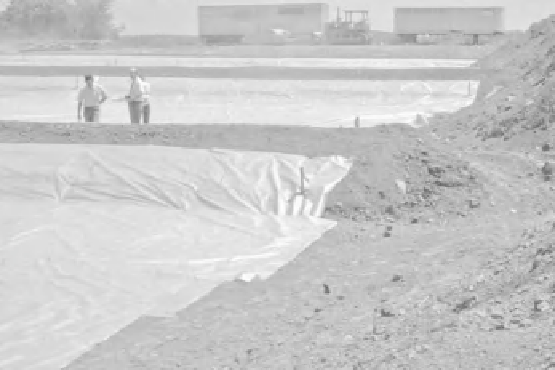Environmental Engineering Reference
In-Depth Information
if possible. Infiltration beds under pervious pavement may be used as temporary
sediment basins or traps provided that they are not excavated to within 12 in.
of the designated bed bottom elevation. Once the site is stabilized and sediment
storage is no longer required, the bed is excavated to final grade and the porous
pavement system is installed.
2. The existing subgrade under the bed areas must not be compacted or subject
to excessive construction equipment traffic prior to geotextile and stone bed
placement.
3. Where erosion of subgrade has caused accumulation of fine materials and/or
surface ponding, this material should be removed with light equipment and the
underlying soils scarified to a minimum depth of 6 in. with a York rake (or
equivalent) and light tractor. All fine grading is done by hand. All bed bottoms
should be level grade.
4. Earthen berms (if used) between infiltration beds are left in place dur-
ing excavation. These berms do not require compaction if proven stable during
construction.
5. Geotextile and bed aggregate are placed immediately after approval of sub-
grade preparation (Figure 8-5). Geotextile is to be placed in accordance with
manufacturer's standards and recommendations. Adjacent strips of geotextile
should overlap a minimum of 18 in. It must also be secured at least 4 feet
outside the bed to prevent any runoff or sediment from entering the storage bed.
This edge strip should remain in place until all bare soils contiguous to beds have
been stabilized and vegetated. Once the site is fully stabilized, excess geotextile
along bed edges can be cut back to the bed edge.
6. Clean (washed) uniformly graded aggregate is placed in the bed in 8-in.
lifts. Each layer should be lightly compacted, with the construction equipment
Figure 8-5
Placement of geotextile beneath infiltration beds, SMS site (now Siemens site),
Chester County, Pennsylvania, 1981.












Search WWH ::

Custom Search